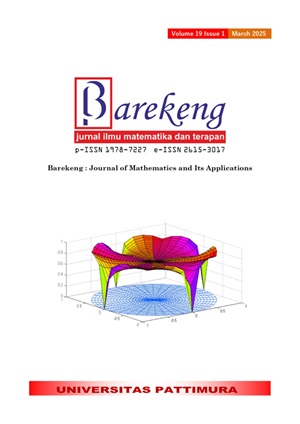CLUSTER ANALYSIS OF K-MEANS AND WARD METHOD IN FORMING A ROBUST PORTFOLIO: AN EMPIRICAL STUDY OF JAKARTA ISLAMIC INDEX
Abstract
Building a portfolio is one method of reducing investment risk. Cluster analysis can shorten the time required to choose companies for a portfolio because it makes it easy to put firms in the same category together. To maintain the best state of the portfolio cluster analysis in the case of data containing outliers, K-means, and ward cluster analysis are employed in conjunction with a robust portfolio strategy. K-means clustering is a popular method for grouping data by assigning observations to clusters based on proximity to the cluster’s center meanwhile the Ward method is based on the size of the distance between clusters by minimizing the number of squares. This study seeks to determine the robust portfolio performance comparison outcomes produced by K-Means and Ward clustering utilizing the Sharpe ratio criterion. The Sharpe ratio is one of the most widely used methods to evaluate a portfolio’s risk-adjusted performance. The greater a portfolio's Sharpe ratio, the better its risk-adjusted performance. Stocks included in the Jakarta Islamic Index 70 (JII70) are used in this research. The results of the formation of a robust portfolio on K-Means clustering produce a return rate of 0.01038627 and risk of 0.1066364, while in the Ward cluster, the portfolio profit rate is obtained at 0.01632749 and the risk is 0.1340073. Based on the Sharpe ratio criteria, in this case, the robust portfolio with the Ward cluster is superior to the K-Means cluster because it produces a higher Sharpe value.
Downloads
References
R. C. Pajar and A. Pustikaningsih, “Pengaruh motivasi investasi dan pengetahuan investasi terhadap minat investasi di pasar modal pada mahasiswa FE UNY,” J. Profita Kaji. Ilmu Akunt., vol. 5, no. 1, 2017.
D. Tambunan, “Investasi saham di masa pandemi COVID-19,” J. Khatulistiwa Inform., vol. 4, no. 2, pp. 117–123, 2020.
I. M. Adnyana, Manajemen Investasi dan Portofolio. Jakarta Selatan: Lembaga Penerbitan Universitas Nasional (LPU-UNAS), 2020.
I. Kulali, “Portfolio Optimization Analysis with Markowitz Quadratic Mean-Variance Model,” Eur. J. Bus. Manag., vol. 8, no. 7, pp. 73–79, 2016.
Y. Lee, W. C. Kim, and J. H. Kim, “Achieving portfolio diversification for individuals with low financial sustainability,” Sustainability, vol. 20, no. 17, p. 7073, 2020.
K. Wada, “Outliers in official statistics,” Japanese J. Stat. Data Sci., vol. 3, no. 2, pp. 669–691, 2020.
A. Wicaksono, K-Medians Clustering (Studi Kasus pada Data Jumlah Tenaga Kesehatan Menurut Kabupaten/Kota di Provinsi Jawa Barat Tahun 2015). Bandung: Universitas Pendidikan Indonesia., 2017.
L. Gubu and D. Rosadi, “Robust Mean-Variance Portfolio Selection With Ward And Complete Linkage Clustering Algorithm,” Econ. Comput. Econ. Cybern. Stud. Res., vol. 54, no. 3, 2020.
L. Gubu and D. Rosadi, “Robust mean–variance portfolio selection using cluster analysis: A comparison between Kamila and weighted k-mean clustering,” Asian Econ. Financ. Rev., vol. 10, no. 10, p. 1169, 2020.
E. D. Supandi and Y. Anggara, “Analisis Klaster dalam Pembentukan Portofolio Robust Mean-Variance,” J. Sains Mat. dan Stat., vol. 9, no. 1, pp. 37–47, 2023.
N. S. M. Mussafi, Z. Ismail, and N. A. B. Aziz, “The downside deviation quadratic programming for stock portfolio optimisation: an empirical study of shariah and conventional indices in Indonesia,” Afro-Asian J. Financ. Account., vol. 14, no. 3, pp. 350–371, 2024.
A. Damodaran, “What is the riskfree rate? A Search for the Basic Building Block,” J. New Financ., vol. 1, no. 3, 2020.
N. S. M. Mussafi, “Analisis Risk Asset Portfolio Berbasis Reward To Variability Pada Saham Syariah Di Indonesia Menggunakan Nonlinear Programming,” J. Mat. “MANTIK,” vol. 3, no. 2, pp. 57–64, 2017, doi: 10.15642/mantik.2017.3.2.57-64.
P. Jorion, Value at Risk: The New Benchmark for Managing Financial Risk, 3rd ed. McGraw-Hill, 2007.
H. Ghorbani, “Mahalanobis distance and its application for detecting multivariate outliers,” Facta Univ. Ser. Math. Informatics, pp. 583–595, 2019.
I. R. Sitepu, “Analisis Cluster terhadap Tingkat Pencemaran Udara pada Sektor Industri di Sumatera Selatan,” J. Penelit. Sains, vol. 14, no. 3, 2011.
E. K. Tokuda, C. H. Comin, and L. D. F. Costa, “Revisiting agglomerative clustering,” Phys. A Stat. Mech. its Appl., vol. 585, no. 126433, 2022.
E. Pratama, A. N. Satyahadewi, N. Sulistianingsih, “Analysis Of Optimal Portfolio Formation On Idx30 Indexed Stock With The Mean Absolute Deviation Method,” BAREKENG J. Ilmu Mat. dan Terap., vol. 18, no. 3, pp. 1753–1764, 2024.
L. Ferreira and D. B. Hitchcock, “A comparison of hierarchical methods for clustering functional data,” Commun. Stat. Comput., vol. 38, no. 9, pp. 1925–1949, 2009.
Copyright (c) 2025 Zuva Amalina Zain, Noor Saif Muhammad Mussafi, Epha Diana Supandi

This work is licensed under a Creative Commons Attribution-ShareAlike 4.0 International License.
Authors who publish with this Journal agree to the following terms:
- Author retain copyright and grant the journal right of first publication with the work simultaneously licensed under a creative commons attribution license that allow others to share the work within an acknowledgement of the work’s authorship and initial publication of this journal.
- Authors are able to enter into separate, additional contractual arrangement for the non-exclusive distribution of the journal’s published version of the work (e.g. acknowledgement of its initial publication in this journal).
- Authors are permitted and encouraged to post their work online (e.g. in institutional repositories or on their websites) prior to and during the submission process, as it can lead to productive exchanges, as well as earlier and greater citation of published works.






1.gif)



